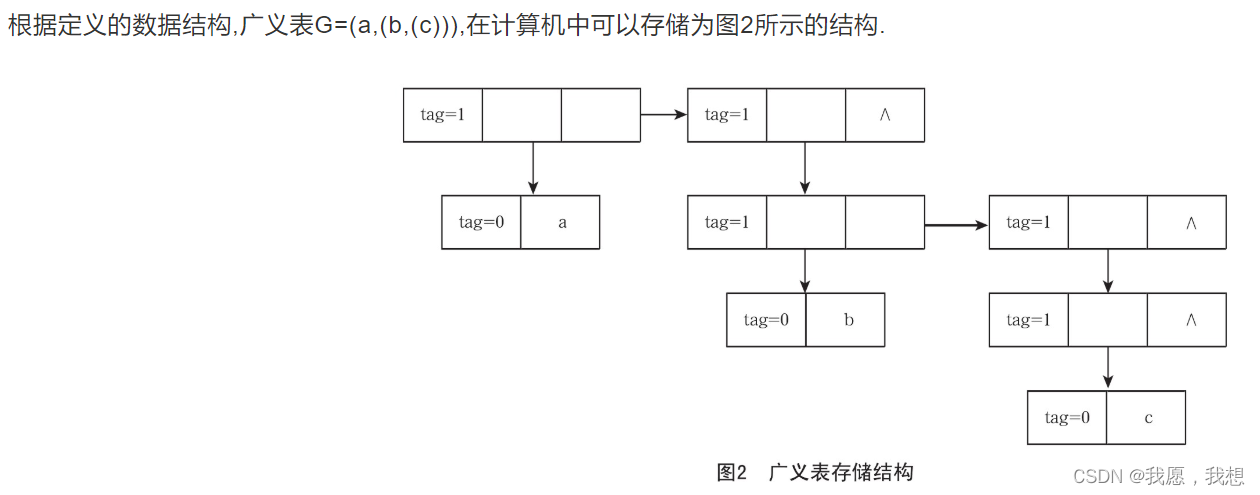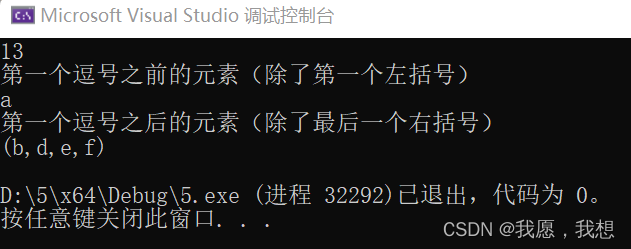-
广义表的学习
一、广义表的定义
- 先举例说明:中国举办的国际足球邀请赛,参赛队名单表示如下:
- (阿根廷,巴西,德国,法国,(),西班牙,意大利,英国,(国家队,山东鲁能,广州恒大))这个表中,叙利亚队应排在法国队后面,但未能参加,成为空表。国家队,山东鲁能,广州恒大均作为东道主的参赛队参加,构成一个小的线性表,成为原线性表的一个数据元素。这种扩宽了的线性表就是广义表。
- 广义表(又称列表Lists)是n>=0个元素a0,a1,....an-1的有限序列,其中每一个aj或者是原子,或者是一个广义表。
- 广义表通常记作:LS=(a1,a2,...an)其中:LS为表名,n为表的长度,每一个ai为表的元素。
- 习惯上,一般用大写字母表示广义表,小写字母表示原子。
- 表头:若LS非空(n>=1)则其第一个元素a1就是表头。记作head(LS)=a1。注:表头可以是原子,也可以是子表。
- 表尾:除了表头之外的其它元素组成的表。记作tail(LS)=(a2,....an)。注:表尾不是最后一个元素,而是一个子表
- 例:
- (1)A=( ) 空表,长度为0
- (2)B=(( )) 有一个元素(该元素为空表),所以长度为1。表头,表尾均为()
- (3)C=(a,(b,c)) 长度为2,由原子a和子表(b,c)构成。表头为a,表尾为((b,c))
- 注意:(b,c)加括号((b,c))表示的是表尾是一个广义表,广义表里有一个元素是(b,c)
- 如果不加括号,(b,c)表示的是表尾是一个广义表,广义表里面有b,c两个元素
- (4)D=(x,y,z) 长度为3,每一项都是原子。表头是x,表尾为(y,z)
- (5)E=(C,D) 长度为2,每一项都是子表。表头为C,表尾为(D)
- (6)F=(a,F) 长度为2,每一项为原子,第二项为它本身。表头为a,表尾为(F)。
- 实际上,F=(a,(a,(a,..)))
二、广义表的性质
- 广义表中的数据元素由相对次序;一个直接前驱和一个直接后继。
- 广义表的长度定义为最外层所包含元素的个数;如,C=(a,(b,c))是长度为2的广义表。
- 广义表的深度定义为该广义表展开后所含括号的重数;
例如:A=(b,c)的深度为1----只有1层括号
B=(A,d)的深度为2----因为B=((b,c),d),有2层括号
C=(f,B,h)的深度为3----因为C=(f,((b,c),d),h),有3层括号
注意:“原子”的深度为0,“空表的深度为1” - 广义表可以为其他广义表共享;如:广义表B就共享表A。在B中不必列出A的值,而是通过名称来引用,B=(A)
- 广义表可以是一个递归的表。如:F=(a,F=(a,(a,(a,..))))注意:递归的深度是无穷值,长度是有限值。
- 广义表是多层次结构,广义表的元素可以是单元素,也可以是子表,而子表的元素还可以是子表,..。例如:D=(E,F) 其中:E=(a,(b,c)),F=(d,(e))
- 广义表和线性表的区别:
广义表可以看成是线性表的推广,线性表是广义表的特例。
三、广义表的2种常见的存储结构
- 广义表中的数据元素可以具有不同的结构(原子或广义表),难以用顺序存储结构表示,通常采用链式存储,将广义表分解为表头和表尾,对表头和表尾再次分解,直到分解到空的广义表或是一个具体的原子,分解结束。
头尾表示法:
- 分解后的表头和表尾各用一个结点表示,显然表头可能为原子或列表(表尾肯定是列表),所以需要两种结构的节点:一种是表结点,一种是原子结点。其中变量tag用来区分表结点和原子结点。
- 表结点:包括标志域(tag),指向表头的指针域(hp),指向表尾的指针域(tp)
- 原子结点:包括标志域(tag),值域(atom)

存储结构类型:
- typedef int AtomType;
- typedef enum
- {
- ATOM,LIST
- }ELemTag;//ATOM=0原子结点,LIST=1子表
- typedef struct GLNode
- {
- AtomType tag;//区分原子结点和表结点的类型参数
- union
- {
- AtomType atom;//原子结点的值域
- struct
- {
- struct GLNode* hp,* tp;
- }htp;
- }atom_htp;//atom_ptr是原子结点的值域atom,表结点的表头指针hp,表尾指针tp的联合体域
- }GLNode,*GList;

- bool Init(GList &L)//初始化,建立一个空的广义表
- {
- L = NULL;
- return true;
- }
- bool CreatGList(GList &L,SString S,char*a)//建立广义表
- {
- L = (GList)malloc(sizeof(GList));//建立表结点
- if (StrLen(S) == 1)
- {
- L->tag = ATOM;
- (L->atom_htp).atom = a[1];//S为单原子,创建单原子广义表
- }
- else
- {
- SString sub
- L->tag = LIST;
- GLNode* p = L;
- SubString(S, sub, 2, StrLen(S)-2);//
- }
- }
- GList Head(GList L)//求广义表的表头
- {
- if (L == NULL)//空表无表头
- {
- return NULL;
- }
- if (L->tag == ATOM)//如果是原子结点则不是表
- {
- exit(0);
- }
- else
- {
- return L->atom_htp.htp.hp;
- }
- }
- GList Tail(GList L)//求广义表的表尾
- {
- if (L == NULL)
- {
- return NULL;
- }
- if (L->tag == ATOM)
- {
- exit(0);
- }
- else
- {
- return L->atom_htp.htp.tp;
- }
- }
- int Length(GList L)//求广义表的长度
- {
- if (L == NULL)
- {
- return 0;
- }
- if (L->tag == ATOM)
- {
- exit(0);
- }
- GList p = L;
- int count = 0;
- while (p != NULL)
- {
- count++;
- p = p->atom_htp.htp.hp;//寻找下一个表结点
- }
- }
- int Depth(GList L)//求广义表的深度
- {
- if (L == NULL)
- {
- return 1;//空表深度为1
- }
- if (L->tag == ATOM)
- {
- return 0;//原子结点的深度为0
- }
- GLNode* p = L;
- int d, max;
- while (p != NULL)
- {
- p = p->atom_htp.htp.hp;//进入下一个表结点
- d = Depth(p);//寻找下一个表结点的深度
- if (d > max)
- {
- max = d;
- }
- p = p->atom_htp.htp.hp;//继续寻找下下一个表节点
- }
- return max + 1;
- }
- int CountAtom(GList L)//统计广义表中原子结点的数目
- {
- int n1 = 0, n2 = 0;//分别计算表头,表尾中原子数目个数
- if (L == NULL)
- {
- return 0;
- }
- if (L->tag == ATOM)
- {
- return 1;
- }
- n1 = CountAtom(L->atom_htp.htp.hp);
- n2 = CountAtom(L->atom_htp.htp.tp);
- return (n1 + n2);
- }
四、关于广义表的取“表头”“表尾”
- #include
- #include
- #include
- #include
- #include
- using namespace std;
- typedef struct {
- char* ch; // 先存放非空串的首地址,不分配内存
- int Length; // 存放串的当前长度
- }SString;
- bool StrInit(SString& S);//初始化
- bool StrAssign(SString& S, char* chars);//一个字符串常量赋值给顺序串S
- bool StrCopy(SString& S, SString T);//将T串拷贝给S串
- bool SubString(SString S, SString& T, int pos, int len);//取子串,此处pos代表元素下标
- int StrLen(SString S);//求串长
- bool Print(SString S);//打印
- bool sever(SString &sub, SString& head);//从串T中分离出头串head
- //将非空串T分割成两部分:head为第一个','之前的子串,T为之后的子串
- bool StrInit(SString& S)//初始化
- {
- S.ch = NULL;
- S.Length = 0;
- return true;
- }
- bool StrAssign(SString& S, char* chars)//一个字符串常量赋值给顺序串S
- {
- int i, j;
- char* c;
- for (i = 0, c = chars; *c; i++, c++);//计算一个字符串常量的长度
- if (i == 0)//说明字符串常量是0,就不用给SString开辟空间
- return false;
- else
- {
- S.ch = (char*)malloc(i * sizeof(char));//申请空间
- if (S.ch == NULL)
- {
- exit(0);
- }
- for (j = 0; j < i; j++)
- {
- S.ch[j] = chars[j];
- S.Length = i;
- }
- }
- return true;
- }
- bool StrCopy(SString& S, SString T)//将T串拷贝给S串
- {
- if (S.ch != NULL)//先释放掉原来的空间
- {
- S.ch = NULL;
- free(S.ch);//注意此处虽然free函数进行了动态内存的释放和回收,但实际中未完全释放,S.ch依然会指向
- //动态开辟的空间,而非指向NULL。当第一次使用完空间,如果未退出继续运行代码,再次赋值就会发生错误,
- //只需在free函数前把S.ch进行赋值NULL操作即可
- }
- if (S.Length != 0)
- {
- StrInit(S);
- }
- for (int i = 0; i < T.Length; i++)
- {
- S.ch = (char*)malloc(T.Length * sizeof(char));
- if (S.ch == NULL)
- return false;
- S.ch[i] = T.ch[i];
- S.Length = T.Length;
- }
- return true;
- }
- bool SubString(SString S, SString& T, int pos, int len)//取子串,此处pos代表元素下标
- {
- if (pos<0 || pos>S.Length - 1 || len<0 || len>S.Length - pos)
- return false;
- else
- {
- if (T.ch != NULL)
- {
- T.ch = NULL;
- free(T.ch);
- }
- if (T.Length != 0)
- StrInit(T);
- int i;
- T.ch = (char*)malloc(len * sizeof(char));
- if (T.ch == NULL)
- return false;
- for (i = 0; i < len; i++)
- {
- T.ch[i] = S.ch[pos + i];
- T.Length = len;
- }
- return true;
- }
- return true;
- }
- int StrLen(SString S)//求串长
- {
- return S.Length;
- }
- bool Print(SString S)//打印
- {
- for (int i = 0; i < S.Length; i++)
- {
- cout << S.ch[i];
- }
- cout << endl;
- return true;
- }
- bool sever(SString &sub, SString& head)//从T串中分离出头串head
- //注意sever处理的是已经除去最外层括号的串
- {
- int n = StrLen(sub);
- int i = 0, k=0 ;//k记尚未配对的左括号个数
- for(i=0;i{char ch = sub.ch[i];if (ch == '('){k++;}else if (ch == ')'){k--;}if(ch==','&&k==0){break;}} //找到第一个','之前的子串的的条件的出现1个左括号//和第一个','if (i < n){SubString(sub, head, 0, i);SubString(sub, sub, i + 1, n - (i+1));}else//串中只有一个字符(单原子)的时候{StrCopy(head, sub);free(sub.ch);StrInit(sub);sub.ch = (char*)malloc(50 * sizeof(char));}return true;}int main(){SString S1;StrInit(S1);S1.ch = (char*)malloc(50 * sizeof(char));char a[] = "(a,(b,d,e,f))";StrAssign(S1, a);//一个字符串常量赋值给顺序串S1cout << StrLen(S1) << endl;SString head;//用于保留分割后的表头StrInit(head);head.ch = (char*)malloc(100 * sizeof(char));SubString(S1, S1, 1, StrLen(S1) - 2);//除去串的最外层括号sever(S1, head);cout << "第一个逗号之前的元素(除了第一个左括号)" << endl;;Print(head);cout << "第一个逗号之后的元素(除了最后一个右括号)" << endl;Print(S1);return 0;}

- 相关阅读:
mqtt安卓客户端
密码学系列之:PKI的证书格式表示X.509
Android Jetpack Compose之确定重组范围并优化重组
Spring AOP
shell脚本学习06(小滴课堂)
LeetCode·84.柱状图中最大的矩形·单调递增栈
《痞子衡嵌入式半月刊》 第 63 期
Apollo自动驾驶平台:从传感器到决策的技术解析
浅析搭建校园在线教学视频汇聚平台的必要性及解决方案
【Linux网络编程】信号和定时器
- 原文地址:https://blog.csdn.net/m0_63783532/article/details/127737791
